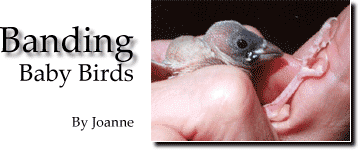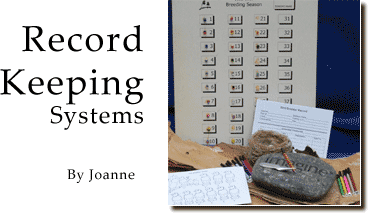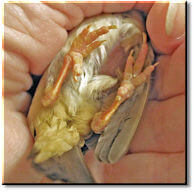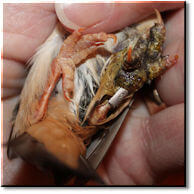 Photo of gouldian nestling
Photo of gouldian nestling
Banding Baby Birds
Bird Breeding
Articles and Information - Lady Gouldian Finch
There are a number of reasons for banding your baby birds. If your birds are very similar looking, you will need a reliable method of identifying them. If you intend to breed, it is important to keep accurate records of their age, sex, family etc. This article will cover banding for breeding purposes only.
Open or Closed?
There are two types of bands- open or closed. The closed bands are made of stainless steel, aluminum or plastic and come in a variety of colors and sizes. Closed bands are the most reliable method of identifying a bird rather than open bands which can be opened and changed at will. I tried to use the closed band on the first baby birds I raised. I broke two baby's toes trying and decided to use the open plastic bands from then on.
Age to band?
Using the open bands, birds can be banded any time in their lives. In order to avoid injury to the baby bird, the best time is when the birds are ready to come out of the nest. If the babies are in an open flight/colony breeding, it is almost impossible to know who belongs to which parents, once they leave the nest.
 Record Keeping Systems - breeding gouldian finches
Record Keeping Systems - breeding gouldian finches
In my record keeping system the family is identified by the color on the right leg band. Depending on the number of pairs set up for the breeding season the leg bands are numbered one through 35 as shown on the wall chart. I found this visual aid to be very helpful when first getting started. However, I found in time I started to remember which color each family represented. The band placed on the left leg represents the year the bird was born. The year bands are numbered 1 thru 100 etc. further indicating the number of birds born in the current breeding season.
Applying Open Bands
Vascular Necrosis
Caused by tight band obstructed blood flow to foot

 Foot sore on gouldian
Foot sore on gouldian
Band removed, Leg cleaned, Scabs removed.
Antibiotic given for 3 days. Leg healed after 18 days.
The band so constricted the leg that as the skin needed to slough off cells, they became impacted beneath the band. The circulation to the foot was seriously compromised and scabs formed on the leg. After the Vet removed the band, 3 days of antibiotics and a couple of weeks in “sick bay,” the leg healed. She’s back in the big cage and it’s as if nothing ever happened. If I ever have a banded bird again, it is straight to the vet’s to get it removed. Thanks again for your input.
Hope the information will be helpful to others.
Chris Wise